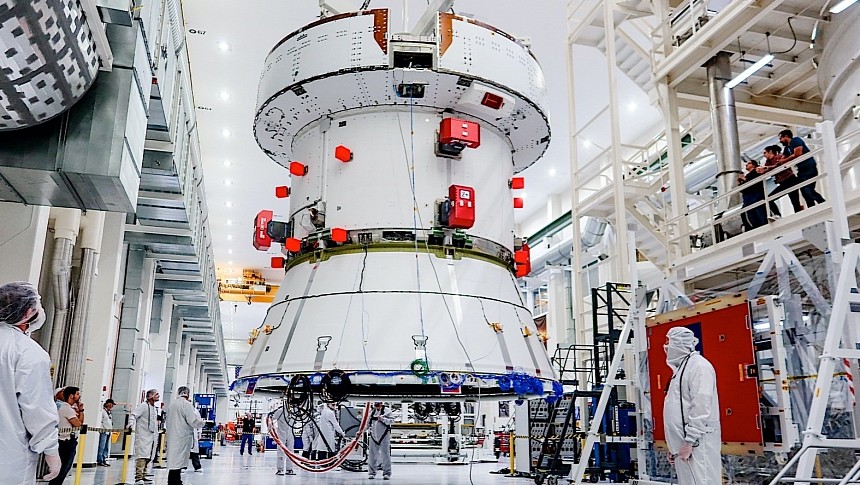We're still more than a year away from the moment when the Orion spaceship will take off atop the Space Launch System rocket with humans on board. A long time for most of us, but just a few busy, busy months for the people working to get the hardware ready for the Artemis II crewed mission.
As the timer counts down, it's likely updates on what's going on over at NASA on this topic will increase in both number and intensity, giving us an ever clearer look at what to expect. This week, for instance, is all about the engines that'll help four humans reach the Moon for the first time in decades.
This week's development has to do with the so-called European Service Module (ESM). It's a complex piece of unpressurized hardware that's of incredible importance for the Orion spaceship because of what it is supposed to do.
That's because it comprises the main engines of the spaceship (there are 33 of them), but also four tanks capable of holding 8,000 liters (2,113 gallons) of fuel. The ESM is not only home to Orion's powerplants and some of its fuel, but it is also responsible for supplying the crew inside the capsule with electricity, water, and oxygen.
During Artemis I, the dry run test flight to the Moon last year, the module performed flawlessly, but as most of the hardware used for this program, it is not reusable. That's why the European Space Agency (ESA) made a second one, called European Service Module II.
This one, together with the adapter that links it to the Orion itself, was moved at the end of May to the Final Assembly and System Testing (FAST) cell at the Kennedy Space Center in Florida.
There, the two large pieces of hardware will be linked with the actual crew module, and when that is done the entire assembly will pass over to the Exploration Ground Systems team for fueling. A formal handover from ESA to NASA is expected to take place later this month.
Artemis II is tentatively scheduled to depart for the Moon in November 2024. There will be a four-person crew on board, and for the first time for a Moon mission it includes a person of color, a woman, and a Canadian: Reid Wiseman, Victor Glover, Christina Koch, and Jeremy Hansen.
The mission does not require the four to land on the Moon, but will take them to the farthest point ever reached by a member of our species: 230,000 miles (370,000 km) away from Earth. That's 6,400 miles (10,300 km) beyond the orbit of the Moon.
Artemis II will last in all about ten days, and it's meant to validate all the systems that will eventually support the landing party of Artemis III.
This week's development has to do with the so-called European Service Module (ESM). It's a complex piece of unpressurized hardware that's of incredible importance for the Orion spaceship because of what it is supposed to do.
That's because it comprises the main engines of the spaceship (there are 33 of them), but also four tanks capable of holding 8,000 liters (2,113 gallons) of fuel. The ESM is not only home to Orion's powerplants and some of its fuel, but it is also responsible for supplying the crew inside the capsule with electricity, water, and oxygen.
During Artemis I, the dry run test flight to the Moon last year, the module performed flawlessly, but as most of the hardware used for this program, it is not reusable. That's why the European Space Agency (ESA) made a second one, called European Service Module II.
This one, together with the adapter that links it to the Orion itself, was moved at the end of May to the Final Assembly and System Testing (FAST) cell at the Kennedy Space Center in Florida.
There, the two large pieces of hardware will be linked with the actual crew module, and when that is done the entire assembly will pass over to the Exploration Ground Systems team for fueling. A formal handover from ESA to NASA is expected to take place later this month.
Artemis II is tentatively scheduled to depart for the Moon in November 2024. There will be a four-person crew on board, and for the first time for a Moon mission it includes a person of color, a woman, and a Canadian: Reid Wiseman, Victor Glover, Christina Koch, and Jeremy Hansen.
The mission does not require the four to land on the Moon, but will take them to the farthest point ever reached by a member of our species: 230,000 miles (370,000 km) away from Earth. That's 6,400 miles (10,300 km) beyond the orbit of the Moon.
Artemis II will last in all about ten days, and it's meant to validate all the systems that will eventually support the landing party of Artemis III.









